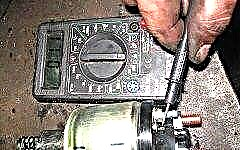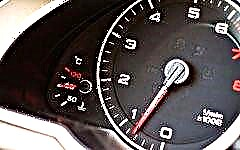

The content of the article:
- Common Causes
- Nuances by engine type
- How to eliminate jumps
Car owners often ask why engine revs float. Causes of malfunction for carburetor, diesel and injection engines. Troubleshooting methods depending on the diagnostic results.
After starting the engine, the driver looks at the tachometer and estimates the speed. If the engine is not warmed up, this parameter is 10-20% higher and eventually drops to 800-900 rpm. But there are situations when the frequency jumps from 500 to 1500 rpm. A number of questions arise as to why the idle speed is floating, and how to fix it.
Common Causes of Floating Idle Speed

Considering why the engine speed floats, it is worth considering the general reasons:
- breakdown in high-voltage (HV) wires;
- failure of one or more candles;
- poor fuel pressure;
- the appearance of moisture in the fuel mixture;
- reduction of compression in the engine cylinders;
- violation in the functioning of the system that provides ventilation of exhaust gases;
- breakdown of the ignition coil, etc.
There can be many reasons for a malfunction, and approaches to normalizing engine speed depend on the detected defect.
Causes of idle speed fluctuations for different engines

Situations with such a malfunction are considered individually. The problem can occur immediately after starting the engine or after a while (after warming up). You need to pay attention to the frequency of occurrence of the problem and the quality of work of other nodes. When considering the reason why idling speed floats, the type of internal combustion engine is taken into account.
Carburetor engine
Domestic cars, except for some models, are equipped with a carburetor. Reasons for "floating" crankshaft speed:
- Errors in the adjustment of the XX motor or failure of settings during the use of the car. In the latter case, the parameters are shifted towards the delay.
- Dirty nozzles or XX system. Under these circumstances, the fuel mixes with a smaller volume of air and it is difficult for the engine to maintain the required speed.
- Suction of more air than necessary. There is a "depletion" of the combustible mixture, because of which the engine chokes, and the speed begins to float.
- Dirty air filter. The air flow to the engine goes through the filter element. If it is clogged, the mixture is oversaturated with gasoline.
- Incorrect carburetor fuel level.
Injection engine
If an injection motor is installed on the machine and electronic injection is provided, there may be other reasons why the idle speed is floating:
- Breakage of one of the sensors (throttle valve or air pressure).
- Worn injectors.
- Failure of the ECU.
- Damage to the regulator XX.
- Draw in the air flow into the intake system.
When assessing the cause, you must start with the XX controller and the sensor that monitors the position of the damper. After that, you can proceed to the control of the mass air flow sensor.
Diesel engine
In cars equipped with a diesel engine, the rpm can float at idle speed due to the appearance of rust on the blades of the fuel pump. With severe corrosion, the device sticks and no longer cope with the task. To solve the problem, you need to add about 200-300 ml of engine oil to the fuel tank.
How to eliminate jumps in engine speed at XX

The actions of the car owner or locksmith at the service station depend on the detected defect. Typically, you have to follow these steps:
1. Adjusting the carburetor or replacing the EM valve. In the latter case, the internal combustion engine works only when the suction is pulled towards itself.
2. Check for the fact that additional air has entered the combustion chamber. For this, the entire air supply path to the intake manifold is examined. Verification is carried out by alternately removing the tubes and testing them with pressure. A special blower is used for work. You can use the WD-40 to make searching easier. After processing the tube at the problem area, the liquid quickly evaporates. It is impossible to "repair" the product, so the only solution is to replace it.3. Cleaning the throttle valve with further installation and adjustment... The product is cleaned in two ways - after dismantling or without removing it from the car. When choosing the first method, you need to discard all the tubes that go to the problem node, reduce the fixation and get the product. To clean the throttle valve, the unit is placed in a bowl and filled with a special compound. To speed up the process, a soft bristled brush is used. After rinsing, wipe the assembly with a clean cloth and put it back in place.

The second way is to clean the throttle element without dismantling. To do this, remove the explosive wires, run the cleaning composition into the device, start the internal combustion engine and additionally top up the cleaning fluid. After work, white exhaust may come out of the pipe. This phenomenon indicates the removal of excess dirt. After the end of the procedure, we return the wires to their place, connect the PC and enter the desired program (a suitable gap is set). If the job is done correctly, the idle speed will not float.
4. Installation of a new regulator XX. To assess the state of the device, we take the "tseshka" and change the resistance. Upon receiving a parameter of 40 to 80 Ohm, the IAC is broken and requires replacement.
5. Installation of the DMRV. In the event of a breakdown of the air flow sensor, the only solution is to replace it. It is pointless to repair the part.
6. Regulation XX. If the idle speed is floating, the problem can be solved by adjusting with a screwdriver. The work is carried out by changing the position of special screws, adjusting the quality and volume of revolutions.
7. Cleaning the crankcase ventilation. To solve the problem, you will have to disassemble the crankcase and get the valve. The product is lowered into a container with cleaning liquid, dried and returned to its original position.
8. Installation of a new carburetor EM valve. If this element fails, the motor runs stably with an extended suction. To solve the problem, we change the EM valve and check it.
9. Cleaning the blades of the injection pump from rust. You will need a cleaning compound that needs to be sprayed onto the fuel tank neck. In the future, we add some engine oil to the tank. The composition will settle on the blades of the injection pump and protect the metal from rust.
10. Cleaning the nozzle XX. 15-20 years ago, the performance of such work caused many difficulties for car owners. Now this is no problem. It is enough to buy a special composition and wait 5-10 minutes. Next, take out the jet and remove the remaining dirt.

In a situation where the engine speed is floating, other work may be required - replacing spark plugs, installing new sensors, adjusting the computer, etc. In the absence of experience, a specialist should find out the cause of the malfunction. He should also be entrusted with car repairs.
Many car owners put off work for later. This cannot be done. It is better to immediately come to the service station, make a deep diagnosis and eliminate the cause of the malfunction.











